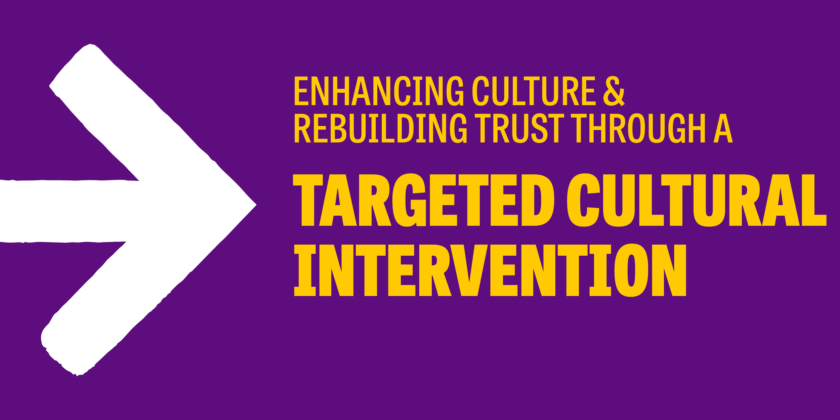Enhancing Culture and Rebuilding Trust Through a Targeted Cultural Intervention

The Challenge
Background
Following concerning results from its annual people survey, an organisation faced critical cultural issues impacting morale, productivity, and retention. Survey responses highlighted staff feeling undermined, reports of bullying and harassment, low trust in leadership, and friction between teams. Recognising the severity of these challenges, the leadership team engaged Let’s Talk Talent to conduct an independent assessment aimed at clarifying the root causes and providing targeted solutions to address these issues.
Objective
To deliver a comprehensive and objective cultural audit to identify and address the root causes behind the reported issues, with an emphasis on rebuilding trust, enhancing communication, and creating a more inclusive and respectful workplace culture.
Goals
- Identify Root Causes and Areas for Improvement
- Conduct an in-depth assessment to clarify underlying issues and cultural misalignments.
- Build Trust and Improve Morale
- Implement interventions focused on fostering trust and ensuring open, transparent communication across the organisation.
- Strengthen Leadership and Management Alignment
- Provide targeted recommendations to bridge the gaps between leadership and staff, enhancing clarity around roles, priorities, and organisational direction.
Approach and Implementation
- Comprehensive Data Collection and Analysis
- Using a combination of survey analysis, employee interviews, focus groups, and open drop-in sessions, we gathered data to understand the depth and nuances of the reported issues. This approach ensured a well-rounded perspective, capturing the voices of employees at all levels.
- Findings and Key Insights
- Our review revealed that while a pervasive culture of bullying was not present, there were notable gaps between leadership and management. These included issues related to communication, inclusivity, and clarity around decision-making processes. Many employees reported feeling disconnected from the organisation’s strategic goals and uncertain about growth opportunities.
- Targeted Recommendations for Positive Cultural Change
- Based on our findings, we provided the organisation with a blend of immediate and long-term actions designed to restore trust and improve team dynamics:
- Regular Pulse Surveys
- To enable ongoing monitoring of morale and to gather continuous feedback, we recommended introducing regular pulse surveys, ensuring employees’ voices remain central to the decision-making process.
- Priority-Setting and Transparent Communication
- We introduced a priority-setting methodology and recommended transparent communication practices for leadership, allowing objectives and organisational direction to be clearly communicated across all levels.
- Managerial Code of Conduct
- To reinforce respectful behaviour and set a clear standard, we established a code of conduct for managers, helping to address and prevent future issues related to undermining and harassment.
- 1:1 Coaching for Leaders and Team Coaching Sessions
- We recommended personalised coaching for leaders to enhance communication and relationship-building skills. Additionally, team coaching was introduced to improve cross-departmental collaboration and strengthen working relationships.
The Results
The interventions led to a positive, measurable impact within the organisation:
- Increased Engagement and Communication
- Pulse surveys revealed a 25% improvement in communication scores within the first few months. Employees felt more connected and aligned with leadership’s direction, boosting overall engagement.
- Reduction in Bullying and Harassment Reports
- Incidents of bullying and harassment decreased, reflecting the organisation’s strengthened focus on respect and inclusivity in day-to-day interactions.
- Rebuilt Trust and Improved Morale
- Leadership’s commitment to transparent communication and prioritising employee well-being fostered trust, even in a high-pressure environment. This commitment to visible leadership and clear expectations positively influenced workplace morale.
Return on Investment (ROI)
The organisation’s commitment to the cultural interventions provided clear returns. Improved engagement, a reduction in ER cases, and higher levels of alignment contributed to a more cohesive, productive, and resilient team culture. The foundation laid by the culture audit and ongoing coaching has enabled sustained positive change across the organisation, setting a pathway for future growth and success.